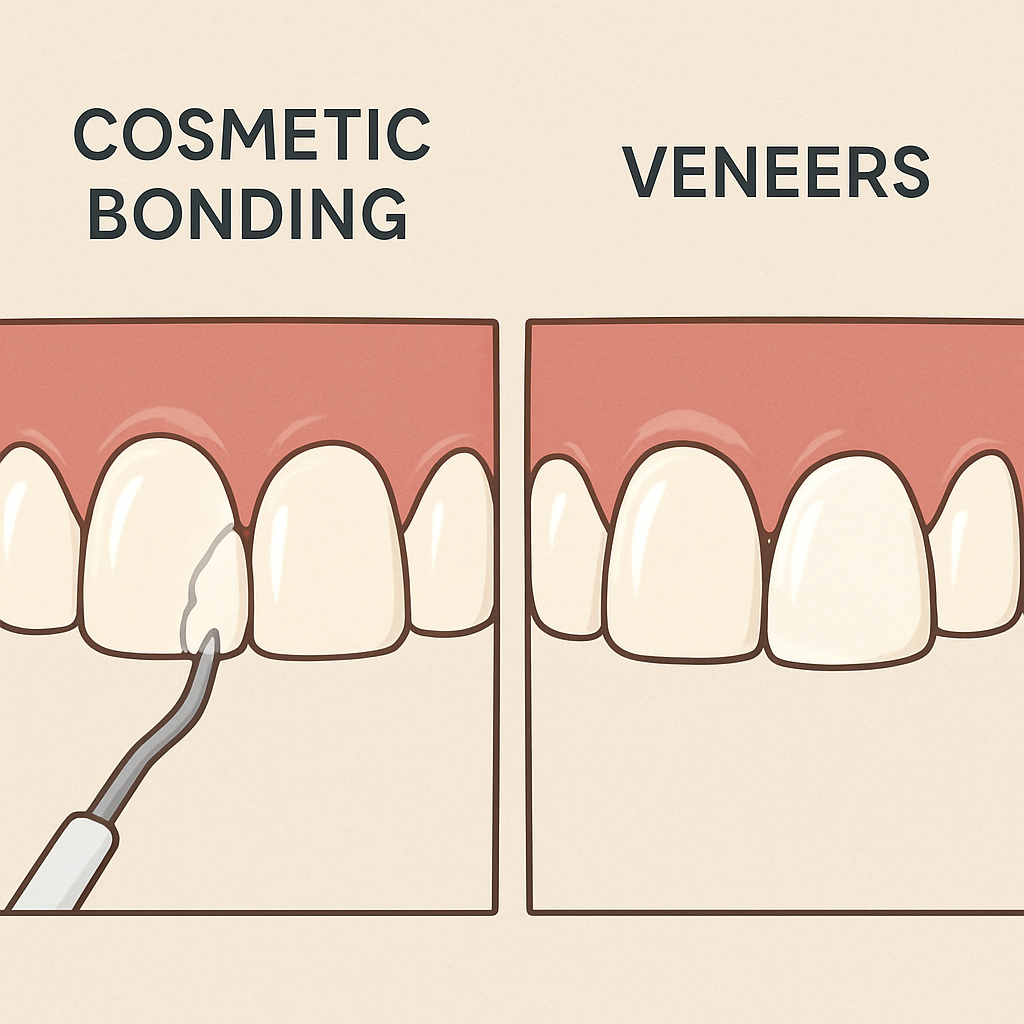Cosmetic Bonding vs Veneers Pros & Cons
Cosmetic dentistry offers many ways to enhance your smile. Two popular options are cosmetic bonding and dental veneers. Both can transform your teeth, but they differ in several ways.
Cosmetic bonding involves applying a resin to correct imperfections. It’s quick and often completed in one visit.
Veneers, on the other hand, are thin shells that cover the front of teeth. They require more preparation and multiple visits.
Choosing between bonding and veneers depends on your needs and budget. Each has its pros and cons. Understanding these differences can help you make an informed decision.
What Are Cosmetic Bonding and Veneers?
Cosmetic bonding and veneers are key treatments in cosmetic dentistry. Both aim to enhance the aesthetic appeal of your teeth. They address issues like discoloration, gaps, and irregular shapes.
Cosmetic bonding uses a tooth-colored resin. It’s applied directly to the tooth surface and then molded into the desired shape. This option is quick, often completed in just one dental visit.
Veneers are thin shells made from porcelain or composite resin. They are bonded to the front of the teeth. Veneers often require multiple visits for preparation and fitting.
Here’s how they differ:
| Material: | Bonding uses resin; veneers use porcelain or composite. |
| Procedure length: | Bonding is quick; veneers take longer. |
| Durability: | Veneers are generally more durable than bonding. |

How Cosmetic Bonding Works
Cosmetic bonding is a straightforward process. It starts with a thorough cleaning of the tooth surface. This ensures that the resin adheres properly.
Next, a mild etching solution roughens the enamel. This step prepares the surface for better bonding. Following this, the dentist applies the tooth-colored resin.
The resin is then carefully shaped and molded. The dentist uses tools to adjust it to the desired form. A special light hardens the resin quickly, setting it in place.
Finally, the bonded tooth is polished. This step ensures a smooth finish. It also matches the sheen of your natural teeth.
- Step 1: Clean and prepare the tooth.
- Step 2: Apply etching solution.
- Step 3: Place and shape the resin.
- Step 4: Harden the resin with light.
- Step 5: Polish for a final finish.
How Dental Veneers Work
Dental veneers involve a meticulous process. Initially, a thin layer of enamel is removed. This removal accommodates the thickness of the veneer.
After enamel removal, the dentist takes an impression. This impression is vital for creating custom veneers. It ensures each veneer fits perfectly.
The dental lab then crafts the veneers. This step can take a couple of weeks. During this time, temporary veneers may be placed.
Once ready, the permanent veneers are bonded to the teeth. A special adhesive holds them securely. The result is a durable and aesthetic enhancement.
- Step 1: Remove a small amount of enamel.
- Step 2: Take a detailed dental impression.
- Step 3: Craft veneers in a lab.
- Step 4: Bond veneers using adhesive.
Pros and Cons of Cosmetic Bonding
Cosmetic bonding is a versatile solution for minor cosmetic dental issues. It uses a tooth-colored resin applied to the teeth. This procedure can improve appearance quickly.
There are several advantages to cosmetic bonding. It’s generally more affordable than other cosmetic dental options. It also typically requires only a single dentist visit.
Despite these benefits, bonding has its drawbacks. The material is not as strong as other options. It may chip or wear down over time, requiring maintenance.
Staining is another concern with bonding. The resin can absorb stains from coffee, tea, or tobacco. This can alter the appearance over time.
Pros of Cosmetic Bonding:
- Cost-effective procedure
- Quick results, often in one visit
- Less enamel removal is required
Cons of Cosmetic Bonding:
- Less durability
- Prone to staining over time
Cosmetic bonding is ideal for minor aesthetic improvements. It’s a flexible option for addressing small dental imperfections.
However, it’s essential to weigh these benefits against potential maintenance needs.
Pros and Cons of Dental Veneers
Dental veneers are popular for those seeking a long-lasting smile transformation. These thin, custom shells cover the front surface of teeth, offering a dramatic improvement.
One significant advantage of veneers is their durability. They typically last between 10-15 years or longer with proper care. Additionally, veneers resist stains better than other options.
However, veneers come with some considerations. They require the removal of a small amount of enamel from the teeth. This makes the procedure irreversible, unlike bonding.
Moreover, veneers require more time and financial commitment. The process usually involves multiple dental visits for a perfect fit. It’s essential to consult with a skilled dentist for optimal results.
Pros of Dental Veneers:
- Long-lasting and durable
- Highly resistant to stains
- Custom-fitted for a natural look
Cons of Dental Veneers:
- Irreversible procedure
- Requires more time and cost
- Enamel removal necessary
Veneers provide a polished, uniform appearance, enhancing the overall aesthetic. They suit those prioritizing durability and significant change. Yet, weighing these factors against the investment required is crucial.

Cost Comparison
The cost is a significant factor when choosing cosmetic dental options. Cosmetic bonding tends to be more affordable than veneers, making it an attractive option for budget-conscious individuals.
Bonding generally involves fewer materials and less time spent at the dentist’s office. This contributes to its lower price point. However, while initial costs are lower, touch-ups may be needed over time.
In contrast, veneers require more preparation and are more expensive. They offer better durability and longer-lasting results. Consider your long-term investment when deciding which option suits your needs best.
Cost Considerations:
- Bonding: Lower upfront costs, potential for additional future expenses.
- Veneers: Higher upfront costs, longer-lasting investment.
Durability and Longevity
When considering dental enhancements, durability is crucial. Cosmetic bonding typically lasts between 3 to 10 years. However, it may require maintenance due to its susceptibility to chipping and staining.
In contrast, dental veneers are known for their impressive longevity. On average, veneers can last 10 to 15 years or even longer with proper care. Their resilience against wear and tear makes veneers a preferred choice for many.
Choose based on your lifestyle and how you care for your teeth. Regular dental check-ups are key to maximizing their lifespan.
Longevity Summary:
- Bonding: 3-10 years, may need touch-ups.
- Veneers: 10-15+ years, more durable.
Appearance and Aesthetics
Cosmetic bonding and dental veneers differ in their finishing and look.
Bonding involves a resin material that is sculpted and polished to match the surrounding teeth.
Veneers, on the other hand, are custom-made to offer a more natural and translucent appearance.
They can provide a uniform and symmetrical smile, making them ideal for significant aesthetic improvements.
Ultimately, the choice depends on the desired look and personal preference. Consultation with a cosmetic dentist can help match your needs.
Aesthetics Overview:
- Bonding: Resemble natural teeth, less polished.
- Veneers: Custom-made, more refined look.
Suitability: Who Should Choose Which?
Deciding between cosmetic bonding and veneers hinges on individual dental needs and goals.
Bonding is suitable for those seeking quick fixes for minor imperfections like chips or slight discoloration.
Veneers offer a long-term solution, especially suitable for those wanting to correct significant issues like misalignment or large gaps.
Patients desiring a complete smile makeover often favor veneers.
Both options have their unique strengths. Consultation with a dental professional will pinpoint which treatment aligns best with personal needs.
Ideal Candidates for Each:
- Bonding: Quick fixes, minor adjustments.
- Veneers: Major transformations, long-term solutions.
Maintenance and Aftercare
Proper maintenance and aftercare are vital for both cosmetic bonding and veneers to ensure longevity and appearance. Regular dental check-ups help identify and address potential issues early.
Both procedures require good oral hygiene practices. Avoid biting into hard objects, as it can damage both materials. For veneers, a soft-bristled toothbrush and non-abrasive toothpaste maintain their polish.
Key Maintenance Tips:
- Regular dental visits
- Gentle brushing and flossing
- Avoid hard foods and objects
Making the Right Choice for Your Smile
Choosing between cosmetic bonding and veneers depends on several personal factors. Understand your needs and desired outcomes when considering options.
Considerations for Choosing:
- Budget constraints
- Desired cosmetic outcome
- Time commitment for procedures
Frequently Asked Questions
Is cosmetic bonding painful?
Cosmetic bonding is usually painless, often not requiring anesthesia. It involves minimal discomfort as it doesn’t involve invasive steps.
How long do dental veneers last?
Dental veneers can last over a decade with proper care. Regular dental check-ups and good oral hygiene are key to their longevity.
Can veneers stain like natural teeth?
Veneers resist stains from foods and drinks better than natural teeth. They maintain their shade much longer, but avoiding stain-causing habits helps.
Schedule a consultation at Henderson Family Dental
Schedule a consultation or call us at 214-823-2182. Let us help you achieve the radiant, confident smile you deserve! Check our reviews on Yelp to read our customers’ testimonials.
